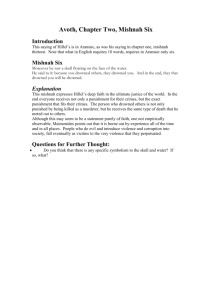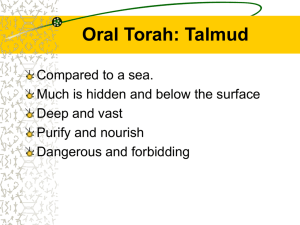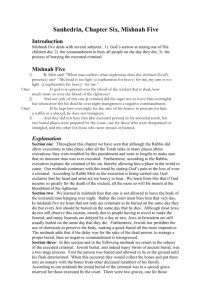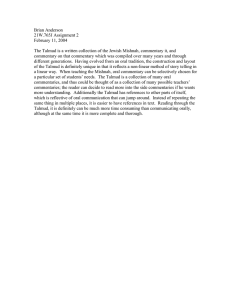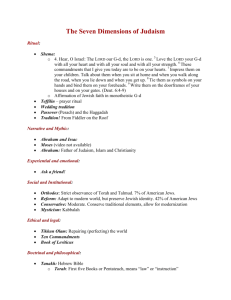P a L
advertisement
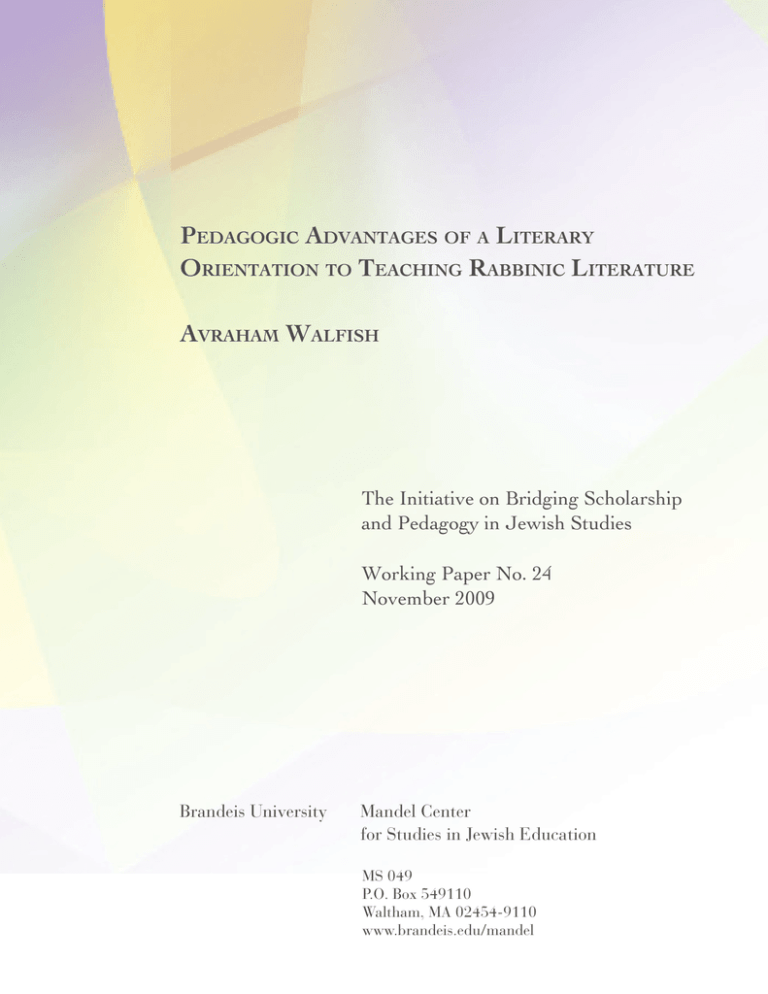
P edagogic Advantages of a Literary Orientation (Bridging Initiative Working Paper No. 24) • 1 Pedagogic Advantages of a Literary Orientation to Teaching Rabbinic Literature Avraham Walfish The Initiative on Bridging Scholarship and Pedagogy in Jewish Studies Working Paper No. 24 November 2009 Brandeis University Mandel Center for Studies in Jewish Education MS 049 P.O. Box 549110 Waltham, MA 02454-9110 www.brandeis.edu/mandel P edagogic Advantages of a Literary Orientation (Bridging Initiative Working Paper No. 24) • 1 Pedagogic Advantages of a Litereary Oreintation to Teaching Rabbinic Literature Avraham Walfish Abstract This paper explores a teaching orientation to Mishnah and Talmud that emphasizes their literary qualities as sophisticated, well-constructed compositions. It illustrates ways in which verbal cues embedded in the text may be used by a skillful instructor to promote skills development, while also serving as a point of departure for values-based analysis and discussion. The author also discusses how a literary orientation, drawing on academic methodologies that do not undermining the cohesiveness of the text, can serve as an ideologically non-threatening mode of integrating rabbinic and academic scholarship, and how adopting such an orientation may help foster a classroom dynamic based on joint exploration by teacher and student rather than frontal instruction. I Rabbinic texts present serious challenges to the teacher, both in terms of the skills necessary for the student to comprehend the text and in terms of the values and ideas that are often distant from the world inhabited by his students. Representatives of both traditional yeshiva learning and academic scholarship have suggested various innovative methods of teaching rabbinic texts, especially gemara, the vast majority of which have focused on cultivation of skills. By focusing on keywords and technical terms, the student is enabled to break down the text of the gemara into its component parts and see how they interact. While the skills-oriented approaches developed by “yeshivish” and academic scholars share many features, the heavy focus on the building blocks of the sugya tends to foreground the differences (and potential conflicts) between the former’s postulation of carefully-redacted and well-constructed texts and the latter’s philological method grounded in identifying the historical strata embedded Avraham Walfish teaches Talmud and rabbinic thought at the Herzog College in Alon Shvut, Bar Ilan University, and the Tekoah Yeshiva. An ordained Orthodox rabbi, he wrote his doctoral dissertation on the literary features of Mishnah and their meaning, and has authored numerous articles on methods of reading and teaching Mishnah, Tosefta, Talmud, and midrash. P edagogic Advantages of a Literary Orientation (Bridging Initiative Working Paper No. 24) • 2 in the text. The revadim (talmudic layers) controversy that erupted in Israel a few years ago1 highlighted the deep suspicion with which the world of traditional Orthodoxy regards the presuppositions and goals of philologically-oriented modes of study; the impressive pedigree of this approach as found in traditional sources, ranging from the geonim to the Lubavitcher Rebbe and the Netziv, failed to rescue it from charges of secularism and subversion. In recent years, some scholars in the world of academic scholarship have sought to address the problems and issues of talmudic texts by employing synchronic rather than diachronic methods. Utilizing the tools of literary analysis, applied successfully to the biblical text by biblical scholars and teachers, these scholars attempt to understand how the final redaction of talmudic texts combines the frequently disparate component parts into an integrated whole greater than the sum of its parts. From a scholarly point of view, there are two main advantages to this approach: • It accounts for features of the text, such as wordplays, parallelisms, and other forms of verbal associations, which other approaches have not addressed. • It affords a means of understanding the redaction of talmudic texts synchronically, focusing on their meaning (Dilthey’s verstehen2) as they are, rather than being limited to the diachronic investigation of the alleged process by means of which an incoherent text evolved. To some extent these claims – stated here in very brief fashion – will be illustrated in this paper, but my emphasis here will be on how adopting a literary orientation, based on approaching a talmudic text as an integrated whole, can promote meaningful encounter between student and text, making use of academic methodology and discipline, while sidestepping – or arguably transcending – the text-critical premises that often offend the sensibilities of Orthodox educators. II I begin with a source I have taught many times in a variety of frameworks, from fourth grade to university classrooms, and in lectures before synagogue laypersons as well as at scholarly conferences. The Revadim method of Talmud study, designed by Rabbi Dr. Pinchas Hayman, is a program for teaching Talmud to schoolchildren which utilizes tools associated with academic Talmud scholarship, especially the focus on the revadim (layers) of sources embedded in the redacted Talmudic discussion. See description of the method at the Revadim website, http://www.talmud-revadim.co.il/textlist.php. Several years ago there was a stormy debate in Israeli Religious Zionist circles regarding the propriety of studying and teaching Talmud in this manner – see website of Hatzofeh, under Revadim (Hebrew) and see further Rav Yuval Cherlow’s presentation of the issues underlying the debate at http://www.ypt.co.il/ show.asp?id=25420. 1 The German term “verstehen”, meaning “understanding”, was employed by the German philosopher Wilhelm Dilthey to connote empathetic “understanding from within”, which he argued was the kind of understanding appropriate to “human sciences”, as opposed to natural sciences. Although Dilthey’s distinction has been criticized as naïve romanticism (see thorough discussion in Michael Martin, The Uses of Understanding in Social Science – Verstehen, Transaction Publishers, New Brunswick and London 2000, part of which may be seen online at http://books.google.co.il/books?id=9Ptp0SEfSFwC&pr intsec=frontcover&source=gbs_navlinks_s), I believe that the basic insight regarding the differentiation between the goals and tools of human “sciences” and of natural sciences remains accurate and valuable. 2 P edagogic Advantages of a Literary Orientation (Bridging Initiative Working Paper No. 24) • 3 The first two mishnahs of the second chapter of Masekhet Ta’anit describe a service performed on the most serious public fast days, opening in mishnah 1 with a ceremony fraught with symbolism of exile and destruction. Removing the ark of the Torah from the synagogue to the public square, while placing ashes on the heads of the community and their leaders as well as on the ark, express a sense of desolation and underscore the call for penance in the homily of the eldest of the elders. The second mishnah continues the service with the special prayers recited on the fast day, including the special qualities demanded of the elder who serves as prayer leader on this occasion, as well as the expansion of the standard eighteen-benediction daily prayer with several additional benedictions. These two mishnahs, describing two stages of the service, provide several opportunities for students of all ages, levels, and backgrounds to note how the Mishnah’s language interweaves different practices and themes. For example, the fact that the service both in mishnah 1 and in mishnah 2 is led by a zaqen, an “elder”, opens the door for a discussion that involves skills and content, as well as values. On the level of skills, the ability of the student to identify the common term zaqen is an important skill, especially in the earlier grades, and identifying how the specifications of the two elders differ is a textual skill, both important and accessible, which provides important insight into the contents of the two mishnahs. P edagogic Advantages of a Literary Orientation (Bridging Initiative Working Paper No. 24) • 4 Following Bloom’s taxonomy3 from “knowledge” and “comprehension” into the level of “analysis”, the teacher many now ask questions that nudge the content in the direction of values: Why, more than other services, does the service on a public fast day require the leadership of “elders”? Why are there different specifications for the two elders, the one who exhorts to penance and the one who leads the prayers? Responding to these questions, especially the latter, redoubles the focus on skills and content, examining the text and reflecting upon it in order to understand the significance of the different specifications: The elder who exhorts should be venerable, with a wealth of life experience, in short “the eldest among them”; the elder who prays should be adept and well-versed in praying (“ragil”—accustomed) and his personal qualities should guarantee a heartfelt prayer, namely children to feed and an empty cupboard. Understanding the significance of these details calls upon the students’ – and teachers’ – own life experience and enriches it, inasmuch as they are called upon to reflect how they would react to different kinds of homilists and prayer leaders: Why would they respond less favorably to an exhortation by the distraught elder who can’t feed his children, and why would the prayers of the venerable eldest elder be less inspiring? A second textual detail will tend to slip by unnoticed by teachers unaccustomed to searching for verbal associations. Both mishnah 1 and mishnah 2 refer to the teivah, the Ark of the Torah. Whereas in mishnah 1 the Ark plays a central role in the service, both because of its unusual location and because of the ceremonial placing of ashes upon it, in mishnah 2 it seems to be nothing more than a hackneyed figure of speech, inasmuch as “descending before the Ark” is a standard term, like the more common “passing before the Ark”, to describe leading a public prayer. However, the wordplay between the two adjacent mishnahs suggests that perhaps, here as elsewhere in the Mishnah, the redactor revives a dead figure of speech by means of a verbal association. Regardless of the linguistic and conceptual intentions of the Mishnah redactor, guiding the students to noticing the common word teivah may be exploited for educational purposes that go far beyond the close attention to the text and the skills involved in identifying similar words and comprehending their similarities and differences. Why indeed was the teivah referred to in both mishnahs? Does the exile and mourning (ashes) of the teivah in mishnah 1 represent the exile of the Torah whose precepts have been ignored, or perhaps the exile and mourning of God Himself, Whose Presence is represented by His Revealed Word? Or are both, as the Zohar indicates, one and the same? Positioning the prayer leader before the teivah would seem to support the idea that the Ark represents the Presence of God; however, one might argue that praying towards the vehicle of God’s Law serves an additional function, emphasizing the interdependence of opening oneself to hearing God’s Word and presenting one’s petitions before the Almighty. The teacher can guide students to numerous sources which support each of these two ideas, and the discussion of what seemed to be a throwaway phrase in the Mishnah may lead to profound reflection on synagogue architecture and the dynamic of the prayer service. Bloom’s taxonomy is a classification of educational objectives, which he viewed as hierarchical, necessitating an educational strategy which progressed from questions belonging to the more basic objectives to questions belonging to higherlevel objectives. See http://en.wikipedia.org/wiki/Bloom%27s_taxonomy and http://www.coun.uvic.ca/learning/exams/ blooms-taxonomy.html. 3 P edagogic Advantages of a Literary Orientation (Bridging Initiative Working Paper No. 24) • 5 The third verbal association between mishnahs 1 and 2 is, to my mind, both the most interesting and the most profound. Upon encountering the phrase in mishnah 2, kedei sheyeheh libbo shalem batefillah, that his heart may be whole in his prayer, students—whatever their age—when asked where and how mishnah 1 referred to the heart of the participant in the service, will have little difficulty in locating the concluding words of the hortatory peroration (which are taken from the book of Joel): vekir’u levavchem v’al bigdeichem, and rend your hearts rather than your clothes. Nor will they have difficulty in recognizing the apparent contradiction between the two propositions: should one’s heart be torn – or whole? Intelligent fourth-graders can also note – perhaps with a little guidance – that the “contradiction” is rooted in the employment of a common metaphor to express different meanings: the “torn” heart represents the sorrow and regret of the penitent sinner, whereas the “whole” heart represents the single-minded concentration of one’s spiritual energies upon prayer. This exercise in careful reading of mishnaic language may readily be seen as both sharpening the students’ verbal skills and fostering absorption and retention of the contents. However, both student and teacher may find that this sophisticated verbal cue serves a further goal in the realm of values—namely, to suggest that the “torn” heart and the “whole” heart are – as suggested by the Kotzker Rebbe’s famous aphorism – one and the same: “There is nothing as whole in this world as a broken heart.” The application of this spiritual insight to the fast day service is readily apparent, and links up with a theme that may be profitably discussed at several points in the first chapter of the tractate. Inasmuch as fasting is a response to unanswered prayers, as emphasized in the Mishnah’s first chapter, one may ponder whether fasting comes to improve the prayer – or the pray-er? The first two mishnahs of chapter 2 suggest that both answers are correct and indeed the fast day service aims at both goals. However, the wordplays that link these two mishnahs, especially the one concerning the torn and whole heart, suggest that the two answers are intertwined: one cannot wholeheartedly devote his prayers to God when his heart remains “untorn”. In this example, we see that a subtle textual cue can open a window to what Barry Holtz has termed a “big idea”,4 the spiritual ramifications of which far transcend the bounds of Masekhet Ta’anit. Each of the wordplays featured in these two mishnahs may be discussed on its own, or they may be discussed in light of one another. Depending on time limits and other constraints, the teacher may decide to develop these points fully, perhaps assisting the students to pursue their echoes and ramifications in other sources outside of tractate Ta’anit, or might rather prefer to narrow the educational focus to one or another aspect of the foregoing discussion. III In the following source, the Mishnah – characteristically – presents a rather central part of the laws of prayer by means of a series of unusual and problematic cases: 4 Textual Knowledge, New York 2003, pp. 88ff. P edagogic Advantages of a Literary Orientation (Bridging Initiative Working Paper No. 24) • 6 The opening sentence, requiring a donkey rider to descend, if he can, in order to pray, might be read as obliquely indicating the obligation to recite prayers while standing. However, the following statements in the Mishnah indicate that the requirement of standing is not the Mishnah’s main concern; rather the Mishnah focuses on a different demand regarding the physical positioning of the prayer: the direction towards which one should pray. In the first case of mishnah 4, the pray-er should descend from the donkey in order to orient his body towards the place of the Holy of Holies; in the second case, unable to descend and direct his body, he should turn his face in the proper direction; in the third case, unable even to turn his face, he should at least direct his heart towards the Holy of Holies.5 Similarly, in Mishnah 5, the pray-er doesn’t know in which direction to orient himself physically, hence he may simply direct his heart in the right direction. Why should prayer be directed towards the Holy of Holies? Students may suggest various explanations, and in the course of discussing their merits and ramifications, an important consideration that may be raised is the wordplay linking the geographic yekhaven et libbo (he should direct his heart) with the spiritual sheyekhavnu et libbam (that they might direct their heart) which appears at the beginning of the next chapter of the Mishnah: At this point in the discussion, I would deem it advisable for the teacher to take this expression literally, meaning that the pray-er directs his heart towards the geographic locale of the Holy of Holies, as understood (among others) by Levi Ginzberg. Exposing the students to Lieberman’s interpretation, in which the “Holy of Holies” mentioned in this Mishnah is understood as God’s heavenly abode (see discussion in U. Ehrlich, The Non-Verbal Language of Jewish Prayer [Hebrew], pp. 79-80) may be done at a later stage of study – whether in discussion or in an assignment – by examining the Yerushalmi’s discussion, cited below. 5 P edagogic Advantages of a Literary Orientation (Bridging Initiative Working Paper No. 24) • 7 Here, again, both identifying the wordplay and differentiating the two uses of the shared phrase promote important reading skills, while fostering and deepening the understanding and retention of content. Discussion of the differences between the two mishnahs can serve as a highly instructive illustration of characteristic differences between halakhic and aggadic formulations: on the one hand, the well-defined and easily attained technical halakhic requirement of orienting one’s body or heart geographically, and on the other hand, the aggadic portrayal of an ideal inner spiritual orientation unattainable by most mortals. Once again, however, student and teacher alike may reason that the mishnah deploys the common phrase, directing the heart, in order to connect them, despite their differences. Orienting one’s heart – and preferably one’s body as well – towards the Holy of Holies may help the pray-er to direct his heart towards God (termed aptly “the Place”). This, in turn – as noted by Uri Ehrlich – may be further supported by noting the use of the phrase mekhuvan keneged beit qodesh haqodashim (oriented towards the place of the Holy of Holies) in mishnah 9:5 in order to command respectful behavior in the vicinity of the Divine Presence: The halakhic requirement of geographic orientation may thus be perceived as a minimal baseline fulfillment of the aggadic desideratum of attaining thoroughgoing mental-spiritual orientation. Here again, as in the previous text from tractate Taanit, the deployment of keywords in different contexts with different connotations serves teacher and student as a trigger for discussion of central concepts and values associated with the halakhot discussed in the Mishnah. Here, the teacher may decide – for more advanced students – to provide a contrasting viewpoint. The Tosefta also presents the requirement of geographic orientation in prayer, and like the Mishnah also presents a case in which one orients oneself towards God in Heaven, rather than towards a geographic locale: P edagogic Advantages of a Literary Orientation (Bridging Initiative Working Paper No. 24) • 8 However, unlike the Mishnah, the Tosefta opens with the non-geographic orientation; moreover, unlike the Mishnah, in the Tosefta the non-geographic orientation towards God Himself is the lower, baseline level of orientation, rather than the highest ideal. Only those who cannot orient their bodies, such as blind people, may suffice with orienting their hearts alone.6 While in this paper we cannot analyze fully these differences between the Mishnah and the Tosefta passages (which I hope to do elsewhere), I would like to focus my remarks on one further difference between the Mishnah and the Tosefta that is accessible to most students, even in lower grades. Tosefta 3:16 concludes with a statement that explains the importance of orienting one’s prayer geographically: “…thus all Israel may be found to be praying towards one place”. The teacher here may ask: Why is it important that all Israel pray towards the same place? How does this idea compare with the idea we derived above from the Mishnah’s wordplays? Discussion of these skills-based questions may open the door to new ideas and values, including the importance of community in prayer, the role of Jewish nationhood in approaching God, and – connecting with ideas suggested in Tosefta 3:15 – the importance of the Land of Israel in uniting Jews as a nation. Finally, this source comparison provides a brief but instructive example of how close reading of Mishnah and Tosefta may be employed as an introduction to the study of Talmud. Once one has studied this Tosefta, it is readily apparent that the bulk of the gemara’s discussion of the issue of the pray-er’s orientation is based on citation of the Tosefta, in a modified, and sometimes expanded version, with some further amoraic discussion: Lieberman, Tosefta Kifshuta, 1, p. 44, explains that “directing the heart” in t 3:15 means directing one’s physical heart (libbo mamash), namely directing the body. 6 P edagogic Advantages of a Literary Orientation (Bridging Initiative Working Paper No. 24) • 9 Having noted differences between the Mishnah’s conceptions and concerns and those of the Tosefta, one may ponder what the purpose of the gemara might be in citing these baraitot. Does the gemara assume correspondence between the viewpoints of the Mishnah and the Tosefta, so that the latter may be read as explaining the former? Perhaps, aware of differences, it intends to present alongside the Mishnah a parallel and different source, allowing the reader to discern where the differences are and to ponder their meaning. Or does the gemara perhaps suggest ways in which the different ideas from the sources might by synthesized? Full discussion of these hermeneutic possibilities can be conducted only with advanced students, but the hermeneutically-aware teacher can raise the question, and in a given sugya can help students find satisfactory answers, or at least discuss the issue in an intelligent and instructive fashion. In our sugya, for example, is a clue that may be profitably explored with higher-level students. After citing the baraita, the gemara cites R. Avin, who grounds the Tosefta’s goal that all Israel should pray towards one place in a homiletic rendering of a verse from Song of Songs, in which the man – representing God – praises the neck of the beloved, representing Israel, as a mountain towards which all mouths turn. In grounding the idea of the Tosefta in this verse, however, R. Avin adds a new wrinkle – uniting the prayers of all Israel (all mankind?) in one place to which all mouths turn renders the place, and presumably the prayers, beloved before God. How does this fit with the Tosefta’s idea: is this a clarification, an expansion, or a subversion? Does R. Avin move the Tosefta’s idea closer to that of the Mishnah, or further away? On yet another level, the Yerushalmi’s discussion provides a context that might shed light on the meaning of R. Avin’s statement, as well as providing further comments to the Tosefta that deserve analysis in their own right: P edagogic Advantages of a Literary Orientation (Bridging Initiative Working Paper No. 24) • 10 While study of the entire sugya in the Yerushalmi will generally not be appropriate or necessary for this purpose, in the right setting selected quotes from the Yerushalmi can enrich the classroom discussion, and/or provide material for homework assignments or student research papers. IV I have enumerated here a host of unanswered questions, for two reasons: (1) In teaching and learning, the asking of questions and the search for answers are often as important as the proposed answers themselves, and (2) The close-reading method often generates open-ended questions, shaping the contours of the discussion without establishing a single correct answer. P edagogic Advantages of a Literary Orientation (Bridging Initiative Working Paper No. 24) • 11 Let me sum up the pedagogic advantages of adopting a literary orientation towards studying and teaching Mishnah, Tosefta, and Talmud, which I have briefly illustrated above: A. Within this orientation, the instructor can focus on readily accessible textual features, such as word-repetitions, thus promoting and enhancing textual skills. B. Literary analysis of the text enables the teacher to provide a smooth and natural transition from textual analysis to discussion and analysis of values and concepts, thus addressing the “values” issue sidestepped by other skill-based curricula. C. Literary analysis focuses on features of the text that “beg for interpretation”, confronting teacher and student alike with a challenging and open-ended task in which they may work as partners rather than the teacher imparting pre-digested knowledge. D. Often ideas discovered or suggested by students that emerge from studying Mishnah and/ or Tosefta guided by the literary orientation will be addressed by one or both Talmuds, thus providing the teacher and student with an opportunity to re-examine and expand the concepts identified in the earlier texts by comparing them with the talmudic discussion. This approach also provides a powerful entry point to the skillful study of the talmudic sugya, inasmuch as the student has already raised questions and encountered ideas that are likely to arise in the gemara. Employing a literary approach that implicitly views the text as well-redacted and well-integrated— and that in any case treats the existing text as an integrated one for purposes of analysis and interpretation--enables the teacher in an Orthodox setting to utilize scholarly tools without involving assumptions regarding the stages of development of the text and methods of differentiating among the historical layers of the text that, in the view of many Orthodox educators, undermines the integrity and the sanctity of the canonical text.7 A final note: Utilizing a literary orientation need not preclude or conflict with judicious use of other orientations. Having employed the text-based close-reading techniques characteristic of the literary orientation, teacher and student will have identified important and suggestive phenomena that may now be interpreted using techniques characteristic of other orientations. The teacher may, for example, choose to use “reader-response” techniques, drawing out students’ reactions to the text and to its verbal artistry as a way of advancing the discussion. Alternately, the teacher might move from close reading to a discussion of how classical commentators read various aspects of the text identified in The teacher of rabbinic texts may profit here from the example of Bible teachers such as Nehama Leibowitz, Yoel ben Nun, Shalom Carmy, and others. See discussion of Yaakov Beasley, “Return of the Pashtanim”, Tradition 42:1, 2009, pp. 67-83, esp. pp. 69-70. 7 P edagogic Advantages of a Literary Orientation (Bridging Initiative Working Paper No. 24) • 12 that reading. The open-ended questions that the literary orientation tends to spawn may readily be used by the teacher to view the material from the standpoint of other orientations. 8 This paper is one of a series of working papers on the teaching of Jewish studies, available for free download from the website of the Initiative on Bridging Scholarship and Pedagogy in Jewish Studies, a project of the Mandel Center for Studies in Jewish Education at Brandeis University. http://www.brandeis.edu/centers/mandel/bridginginitiative.html See Holtz, Textual Knowledge, pp. 92-95 for a discussion of orientations towards teaching Bible. Similar orientations may be useful for teaching Mishnah and Talmud as well. 8
